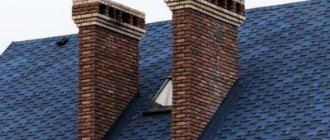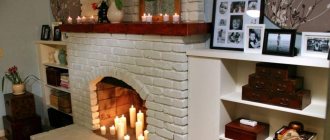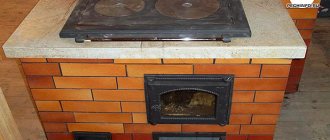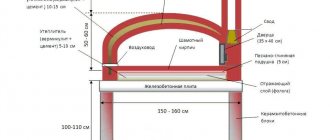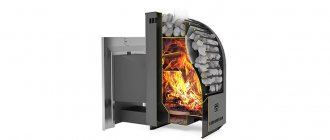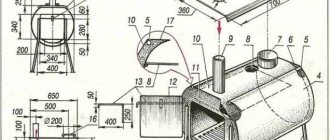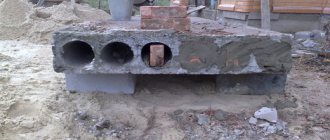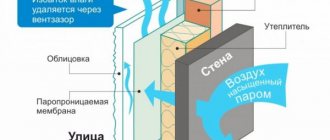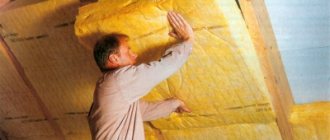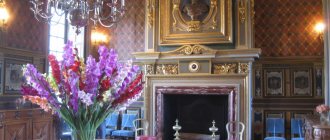Types of outdoor fireplaces
Before you build an outdoor fireplace in a country house or near a private house with your own hands, it is important to decide on the type of structures, which come in the following types:
- fireplace-barbecue;
- decorative;
- mobile.
BBQ oven
An outdoor fireplace with a barbecue function for a summer house or home is very beneficial because it allows you not only to perform a decorative function, but also to prepare healthy food. The complex device is very beneficial for small areas, as it saves space. In addition, due to the presence of the walls, excellent protection from wind is provided, thanks to which the fireplace operates effectively in any climatic conditions.
Outdoor fireplace with barbecue function
Structurally, an outdoor fireplace stove consists of a combustion chamber, a woodpile, a countertop, a washbasin and a roof. Depending on the chosen material for construction, it can be stationary or portable. For stationary brick fireplaces, it is necessary to lay a foundation.
Decorative
Decorative fireplaces are built with the aim of creating a unique design and emphasizing the main focus in landscape design near private houses. They are built mainly from natural stone and decorated with various frescoes or engravings in an ancient or modern style. Their design is classic, but outwardly they look very original.
At the same time, they can be used for their intended purpose. However, you should not count on high efficiency of thermal energy generation, since due to the large number of decorations, the thermal conductivity of the walls of the chimney and combustion chamber is reduced. That is, it is quite possible to warm up next to it on autumn or spring days, but in case of significant cold weather they are ineffective.
During construction, the masonry scheme is relatively simple, but the main difficulty lies in the formation of the cladding. Therefore, only experienced craftsmen can build such fireplaces themselves. You can enjoy the beauty of outdoor decorative fireplaces in the presented photos.
Mobile
Mobile fireplaces are the most popular, as they are available in the most incredible designs made of steel, which are not only compact in size, but also relatively light in weight. That is, it does not permanently occupy a site in the local area, it does not need to be succinctly combined with landscape design, and it does not need to spend a lot of time on production.
To ensure mobility design, one has to be content with mediocre heat transfer and relatively low heat capacity. In other words, while the fire is burning in the furnace, heat is released, and after burning, the entire structure cools down quite quickly.
It is allowed to use natural stone, tiles or granite chips as cladding for external walls. Any home craftsman can make such a design, since the scheme is simple and it is very difficult to make mistakes during installation.
Russian stove: drawings of brick stoves
Russian brick stoves To lay the stove you will need the following materials:
- solid red brick – 1610 pieces;
- view for a valve measuring 0.3x0.3 meters - 2 pieces;
- dry clay solution in dissolved form;
- samovar 14x14 centimeters - 1 piece;
Heating stoves for a brick house - we do it ourselves. To work, you will need the following tools:
- trowel – for laying and leveling the mortar;
- pick - a multifunctional hammer with a blade located perpendicular to the axis of the handle. At its other end there is a square windshield;
- bubble level for masonry and hydraulic for the first row;
- rule - serves to align the bricks of each row;
- plumb lines - one of them must be permanently attached to the axis of the chimney (floor), and with the help of the second the verticality of the corners is checked;
- brush – needed for grouting joints;
- cord - it is pulled over each row of masonry.
Drawings of brick stoves for any type of home look like this:
- Cooking chamber. For masonry, 3/4 ground corner bricks with locks are used.
- Under. There is a slope from the back, for the purpose of which the space is filled with sand, on which the brick is laid.
- Covering the bottom. The structure is covered with bricks along rods, corners or sheet blanks.
- Vault with a castle. In some cases a central lock is used, in others the last two symmetrical bricks are used.
- Rows to the lower arch. The bricklaying of the stove is carried out in the usual way, then a vault template assembled from chipboard or springs cut from wood are installed on top of it.
- Wells. They are tied rows in which a hole is left leading to the underside.
- Sub-bake. Bricks are laid on a foundation mortar; hollow stones are not allowed.
- VK code. For convenience, the bricks are cut into a wedge-shaped shape.
- Covering the channel above the samovar. It is solid, only solid stones are used.
- The holes above the pole become smaller. The brick is cut in accordance with the drawing.
- Alignment of walls. At the same time, the over-pipe is reduced and the samovar channel is laid.
- Installation of a samovar. The structure is closed with a separate lid.
- Installing a view. To embed the structure, two rows are laid.
- Chimney. The height of the pipe from the bottom to the top must be at least 5 meters. The upper rows form a canopy that prevents precipitation from entering the chimney.
Basic structural elements and requirements for them
An outdoor fireplace, built of brick, structurally consists of the following parts:
- The base of the firebox, which is a special platform made of refractory bricks. Designed for placing fuel on it and subsequent combustion. In solid fuel fireplaces, a grate is installed on it to remove burnt coals from the combustion chamber. The location of the fireplace grate above the foundation should be at a level of 8-10 cm. The area of the base of the firebox is at least 70% of the area of the firebox.
- The mouth of the fireplace is a decorative element located on the outside of the firebox. Its height should exceed the depth of the firebox up to 2 times.
- Smoke cornice - is a vault located above the open part of the firebox.
- A mantel is a shelf that is mounted above the chimney cornice and is used to place various decorations or objects on it. Performs a decorative role.
- The fireplace table is a protective base designed to protect the foundation from the effects of high temperatures in the firebox.
- A pre-furnace platform that performs a fire-fighting role. It is located in front of the firebox and is made of fire-resistant materials. Its dimensions must meet the following requirements: protrude forward by a distance of 50 cm, be wider than the portal by 25 cm in both directions.
- The firebox is a niche in the fireplace in which fuel burns. From its front part, thermal energy flows outside the structure for heating. It can be made in the form of various shapes: rectangular, arched, trapezoidal and others.
- Chimney - designed to remove smoke outside the fireplace.
- Smoke chamber with a valve - serves to accumulate thermal energy due to the accumulation of smoke, and the valve is used to regulate the draft and the fuel combustion process.
- Ash pan - for collecting ash and subsequent disposal without stopping fuel combustion.
- Convector is a hood over the fireplace that provides a transition from the chimney ducts to the chimney.
- Deflector – protection of the pipe under significant wind loads, preventing the occurrence of reverse draft.
- A spark arrester is a nozzle on a pipe, made in the form of a head, which is designed to catch sparks and increase fire safety. It is a steel mesh with cell sizes of 3x3 mm.
Fireplace drawing
Structural elements of fireplaces
Size chart for outdoor fireplace
The optimal dimensions of individual structural elements of an outdoor fireplace are shown in the table below.
Optimal dimensions of individual structural elements of an outdoor fireplace
To prevent traction problems, it is recommended to use the following rules:
- the ratio of height to depth of the firebox is 0.5-0.65 to 1;
- the ratio of height to width is 0.6-0.8 to 1;
- width to depth ratio 3:2 or 2:1.
In addition, the presence of a slope of the rear wall of the firebox of 20-220 contributes to an increase in traction. This design also favors greater heat transfer in the frontal direction.
Construction requirements for structural elements
Foundation
The base is designed so that it can withstand the load from the fireplace. Some models weigh from half to a whole ton, depending on overall dimensions. The foundation of the fireplace is made by an independent structure, which does not depend on the foundation of the building for its operation. The laying depth is taken from 30 to 40 cm. The top of the base is made based on the height of the brick below the floor level.
Furnace part
To calculate the optimal volume of the chamber for burning fuel, measure the volume of the room (multiply the width, length, height of the room) and divide by 50. The height and width of the combustion chamber are taken as 2:3, the depth is half or a third of the height while maintaining the specified volume parameters. To better reflect heat rays, a stainless steel metal sheet is installed inside the firebox; sometimes it is deflected to change the angle of the heat flow. The lower base of the firebox is placed 30 cm above the floor in accordance with fire safety requirements. It is advisable to install a threshold at the bottom to prevent fuel or combustion products from falling out. Such a cornice can be used as an additional decorative element.
Chimney
- in order for the fireplace to have a strong draft, the area of the round hole for the smoke to escape is 8 to 15 times smaller than the base of the combustion chamber;
- the chimney on its way out should not have more than three turns;
- the total height of the pipe is at least 5 m;
- the pipe is made of brick or a combined option is provided, when a steel pipe is inserted into the decorative brickwork to remove smoke.
All dimensions and requirements must be outlined in the fireplace drawing, which will become the starting point for starting construction. Drawings are made by hand with reference to existing conditions. Photos of gable design options can be found in specialized catalogs.
How to make a brick fireplace with your own hands?
Planning the construction of a brick fireplace with your own hands is carried out in three main stages:
- the type of structure is determined: closed or open;
- a diagram is developed and a drawing is made;
- the necessary materials and tools are selected.
Closed or open design?
An outdoor fireplace can be built with an open or closed firebox design. The first option is classic and the most attractive, as it allows you to efficiently heat the space in front of it and provide excellent draft for fuel combustion. However, open access to flame creates a high level of fire hazard, especially in well-ventilated areas.
Closed fireplaces, unlike open ones, take longer to warm up the front space. However, they are safer to use and can be used throughout the year. They are more economical, since you can use different types of fuel and not have to deal with wind loads.
Scheme and drawing development
Creating a project for an outdoor fireplace for construction with your own hands is quite simple. To do this, you need to select a site on the site for construction, taking into account the following recommendations:
- It is unacceptable for highly flammable materials, structures, fences, etc. to be located near heated surfaces at a distance closer than 2 m;
- the distance to the neighbor's fence must be at least 5 m;
- it is necessary to take into account the wind rose so that smoke does not flow into the windows of the house or towards the sitting area in front of the fireplace;
- Non-flooded, well-ventilated areas are preferred;
- it is important that the necessary communications are located at a minimum distance.
The design selection and drawing creation is carried out based on the following criteria:
- the base material is selected based on the bearing capacity of the soil and the possibility of laying a solid foundation;
- the main purpose of the structure and its functionality are determined;
- chimney parameters are selected to ensure draft and high-quality smoke removal;
- We think over the decorative cladding and type of decor.
It is recommended to select a ready-made optimal design for an electric fireplace or wood-burning barbecue stove, since the designs have many nuances, and mistakes made can negatively affect their ease of use and functionality. Based on the finished project, you need to calculate the amount of bricks, concrete, fasteners and other necessary structural elements.
Diagram of an outdoor fireplace for barbecue
Then you will need to create a laying plan for the outdoor fireplace so that after preparing the concrete, there are no delays in construction. With its help, you can also make adjustments to the dimensions of finished parts, such as grates, valves, and pipes. The ideal option is to create an order for an outdoor fireplace, which serves as a construction flow chart.
Materials and tools
Based on the drawing, it is necessary to prepare the following materials:
- wall, refractory and facing bricks;
- cement, sand, water for preparing masonry mortar;
- reinforcing bars to strengthen brickwork;
- steel or asbestos-cement pipe for the chimney;
- crushed stone;
- reinforcing mesh.
You will also need the following tools and accessories:
- steel or wooden formwork;
- level;
- bayonet and shovel shovels;
- Master OK;
- bucket for solution;
- concrete mixer;
- jointing;
- mallet;
- roulette;
- pegs and rope.
To lay an outdoor fireplace you will need a level
Fire is the most beautiful and dangerous element; since ancient times it has evoked special feelings in people - it brings a feeling of security, warms and creates comfort, helps to prepare food, and ultimately, it is simply pleasing to the eye. But when arranging your home or site with structures where open fire will be used, you should remember that fire has enormous destructive power and must be handled with care. Most often, stoves or fireplaces are built in private country houses, but if there is no space for it in a small building, they resort to installing an outdoor fireplace.
Content:
- Types of outdoor fireplaces video video
- How to choose the best location for an outdoor fireplace
- We comply with fire safety rules
- Design Features
- What construction tools will you need?
- We stock construction materials
- We are drawing up a project
- Procedure for performing construction work video video
- Finishing work
- Arrangement of the area near the fireplace
Types of outdoor fireplaces
An outdoor fireplace is an excellent opportunity to create an original recreation area on your site. Depending on the availability of free space on the territory and the general design style of the site, the role that will be assigned to the structure, different types of fireplaces can be used.
If the fireplace will be used exclusively for decorating the area and creating a special cozy atmosphere, then it is best to use the classic indoor fireplace option. It will have a similar architectural solution, the only thing that needs to be taken into account is that the outdoor wood-burning fireplace will be affected by precipitation. Materials for making the hearth should be chosen that are fire-resistant; brickwork is usually used as the base; sometimes they resort to using frame structures - gabions.
An outdoor fireplace can be built into a retaining wall, or it can also be located separately from any structures. An excellent backdrop for such a fireplace will be shrubs or decorative trees located behind it. Projects for outdoor fireplaces must necessarily include a high-quality chimney exhaust. You can build such a fireplace with your own hands, but you can resort to buying a ready-made hearth.
An open design fireplace, which is a rounded sheet of metal, will look no less attractive. Outdoor outdoor fireplaces are usually equipped with a barbecue and grill grate.
The location of the open fireplace can be different - it can be buried in the ground, or raised above it. To decorate the fireplace, you can use a backfill of gravel, sand or stones.
Mobile fireplaces have an interesting and neat appearance; they are practical, have a compact shape, design style and height. Such models are attractive because they can easily change location; they may include built-in shelves. Purchased or made with your own hands, such a hearth will be an excellent solution for a small summer cottage; any utility room can be used for storage.
Outdoor grill fireplaces are of particular utilitarian importance; they allow you to prepare original vegetable and meat dishes. Craftsmen build an additional element into the overall design of such a fireplace - a barbecue. You will need to build a canopy for such a fireplace; it is better to place it on an area with a hard surface.
How to choose the best location for an outdoor fireplace
In order for the use of an outdoor fireplace to bring only positive emotions and be comfortable, you will need to correctly determine the location for its construction. Often the optimal location for the fireplace is near a gazebo or patio area - the heat from the fire will warm the people who are there. Considering the most frequent direction of winds, you should position the fireplace so that the smoke from it is not blown by the wind to neighboring areas - this will help to avoid incidents with neighbors. An open veranda, terrace, or winter garden may be a suitable place. The place heated by the fireplace can be used for comfortable relaxation.
We comply with fire safety rules
Although there are no strict regulations on where exactly an open fire should be located, it is still not recommended to neglect fire safety rules. Fireplaces should not be located near buildings made of fire hazardous materials or trees. Also, you should not choose a place near neighboring buildings or a fence - the wind may accidentally carry sparks towards flammable structures.
Features of the design of an outdoor fireplace
The design of an outdoor garden fireplace is very similar to that typical for an indoor fireplace and includes the following elements:
- a foundation that ensures the strength of the structure, its subsidence as a result of soil moisture, preservation of the geometry of the frame and prevents the appearance of cracks;
- a firebox designed for burning wood;
- body with decorative trim;
- chimney
Often, drawings of outdoor fireplaces are made with the addition of optional, but useful fragments, such as seating areas. It is also a good idea to place a firewood rack near the fireplace; it will help make the operation process more convenient and make the object being constructed more attractive.
What construction tools will you need?
The set of tools for building a fireplace is not much different from the traditional one that will be required when building a house:
- different types of shovels: for digging a trench under the foundation and for mixing the solution,
- level, with its help it will be possible to maintain the geometry of the structure parameters, eliminate distortions and uneven surfaces,
- trowel for applying the solution,
- tape measure for taking measurements,
- sieve for sifting sand.
We stock construction materials
The main one will be brick; the frame of the structure and the chimney will be built from it. For work, you will need different types of bricks: fireclay - fireproof, for the construction of the firebox and chimney, for the body - baked clay. In order for the hearth to serve for a long time, it is better to buy high-quality bricks of the first or second grade. If you can’t get fireclay bricks, you will need a steel sheet with a thickness of at least 1.5 mm.
You will also need boards for formwork and scaffolding; you can opt for low-quality material. High quality clay that does not contain impurities should be used as a masonry mortar. It is clay that has a coefficient of thermal expansion similar to brick; this will prevent the appearance of cracks in the masonry when heated to high temperatures.
For finishing work and laying the foundation, you can use cement, preferably grade 500. To save mortar when laying the foundation, you can use natural stones.
We are drawing up a project
Before you create an outdoor fireplace with your own hands, you will need to draw up a project. If you have sufficient preparation, you can develop it yourself. To construct the firebox and chimney, you can use durable and inexpensive materials, and for finishing you can use a wide variety of materials at your discretion: gypsum, facing tiles, artificial or natural stone, or combine these materials. A self-invented option will allow you to give your suburban area a unique, attractive design.
The procedure for performing construction work
Building a fireplace with your own hands will require following the order of work. Let's take a closer look at each of the stages. First, we mark the place and dig a pit. Its depth can be from 15 to 30 cm, depending on the characteristics of the soil in the area. To do this, remove the layer of soil and install the formwork. Next, small stones are placed within the marked base and filled with prepared concrete mortar. Depending on what brand of cement is used, the concrete hardening period can range from 24 to 48 hours.
After making sure that the concrete foundation has hardened, you can begin to lay brickwork. In this case, it is imperative to ensure that each row of pores is laid horizontally and level. Fireclay bricks should be used to lay the space inside the firebox. Compliance with the rules of masonry and high-quality mortar will ensure the reliability of the structure.
Clay mortar is traditionally used for laying ceramic bricks; its structure is homogeneous in composition with brick. The proportions of the components included in the solution depend on whether it will be used for masonry or finishing work. Not one but two components can be used as a binding material: clay and cement. This option will provide greater strength to the masonry. During production, an excess of the binder component should not be allowed in the mixture - if an excess of filler imparts rigidity to the mixture during hardening, then an increased clay content reduces the strength properties. But it is not recommended to completely replace it in the solution with lime or cement.
143. Determining the plasticity (fat content) of a solution with a paddle; a - low plasticity (lean solution); b - medium plasticity (normal), c - high plasticity (bold);
144. Determination of the plasticity of a clay solution using the “ball” method: a - a ball made from a solution of low plasticity (compression of 1/5-1/4 of the diameter). b - ball made of highly plastic solution (compression of 1/2 diameter);
145. Determination of the plasticity of a clay solution using the “flagella” method (on the left - by stretching, on the right - by bending around a rolling pin)
The prepared solution should be viscous and plastic, but should not crumble or be liquid. The thickness of the seams for stove masonry should not exceed 3-4 mm. The proportions of the components depend on the quality of the clay: if it is oily, then take 2 parts of sand for 1 part of the clay; if it is skinny, the amount of sand is reduced. If the sand is fine and the clay is of high quality, the proportion may change 1:1.
Additives to the solution can be made at will; these can be salt - up to 150 g per 10 kg of clay and grade 400 cement - up to 1 kg. To lay 100 bricks you will need to prepare a solution from 2 buckets of clay and 2 buckets of sand. The amount of water can be a quarter of the volume of clay. When the optimal consistency is reached, the stirred mixture will slowly slide off the shovel.
To lay the chimney, it is recommended to use a solution based on lime paste: take 3 parts sand for 1 part lime paste. To make your own lime paste, you will need to mix 1 part quicklime and 3 parts water. The work should be done very carefully - contact with quicklime can lead to burns to the skin and mucous membranes of the respiratory tract. You can buy ready-made lime dough in specialized construction stores. To increase the strength of the lime mortar, they resort to adding cement to it: add 8 parts sand and 1 part cement to 2 parts lime paste. This solution is highly moisture resistant.
To construct the foundation of the fireplace, concrete and heat-resistant concrete mixtures are used. For their preparation, in addition to crushed stone, cement and sand, fireclay sand is also used, which gives the mixture heat-resistant characteristics.
When building an outdoor barbecue or regular fireplace, you should use a beautiful masonry technique - after all, the fireplace will serve not only for utilitarian purposes - it will serve as a decoration for the site. After completing the masonry, all air bubbles should be removed from the mortar; for this purpose, jointing is done. The firebox is left to dry for 48 hours.
Next, the finished chimney pipe is installed or the chimney is laid out of brick in accordance with the project. It is necessary to comply with the requirements of building regulations - only this can guarantee high-quality smoke extraction from the firebox. A shelf must be installed to reduce the backdraft force.
The next step is to fix the fireplace slab, which is the open part of the firebox. The stove must be installed in accordance with all the rules, because... it is a very important fragment of the fireplace. Experts recommend applying the solution to the surface on which the slab will be installed in strips, the distance between them should be 2 cm, the thickness of the mortar strips should also be 2 cm. The slab should be laid level, and when laying, use a mallet with a rubberized striker. The slab should lay flat, without protruding above the level of the firebox.
To give the fireplace an attractive look, an arched design is often included in the design. It complicates the construction process somewhat. Construct arches using templates.
First, knock down a wooden panel of the appropriate size. A semicircle is cut out in it, and a plastic, tin or metal strip is attached to the end. The template is raised, wedges are placed under it, and an arch is erected. Particular attention is paid to tightly fixing the last brick - it is used as a wedge. Upon completion of the construction of the arch, the wedges are removed and the template is dismantled. A correctly folded structure will not collapse.
Finishing work
Having chosen the finishing style and prepared the facing material, you can begin to improve our building. If stone is chosen as the facing material, then a distance of 5 mm should be left between the fragments. The stone should not be fixed at the joints of surfaces with an angle of 90°: the first fireplace stone is attached to the corner, the second is attached with a protrusion of 3 cm, so that their edges meet. It will take no less than 24 hours for the solution to harden after cladding. After constructing the fireplace, you cannot immediately start using it - it must stand for several days and dry well. It is recommended to choose dolomite or basalt as the cladding material. It is undesirable to use rubble granite on surfaces where temperatures can reach over +80 degrees.
Arranging the area near the fireplace
To make the area near the fireplace comfortable for use and attractive in appearance, you will need to work on its design. For example, if an outdoor barbecue fireplace is equipped with firewood, then the areas above them can be tiled. They can be used as working cutting tables, or decorated with vases and beautiful crafts.
The cap of the structure is often given a cone shape; it looks quite attractive. It will also be useful, after several weeks of completion of construction, to coat the surface of the barbecue with a special varnish. The area around the fireplace is laid out with paving slabs.
An outdoor fireplace built according to an original design will decorate a suburban area for many years and fulfill its utilitarian functions.
Author: Sergey and Svetlana Khudentsov
10
Construction technology
The construction of the fireplace is carried out in three stages:
- Laying the foundation.
- Laying walls.
- Chimney installation.
Laying the foundation
The step-by-step construction of the foundation is carried out as follows:
- We mark the selected area: we drive pegs around the perimeter that exceed the dimensions of the fireplace base by 20-30 cm in width and length, and pull a rope over them.
- Use shovels to dig a pit to a depth below freezing of the soil, but not less than 50-70 cm.
- We lay a layer of waterproofing on the bottom, and then 20-30 cm layers of sand and crushed stone, which we carefully compact.
- We install the formwork and lay the reinforcing mesh.
- Mix the concrete and pour it into the formwork.
- After 7 days we remove the formwork.
- We install waterproofing on the side walls.
- The foundation is ready for use after 28 days.
Wall masonry
Laying the walls of a country outdoor fireplace is carried out in the following sequence:
- We prepare a cement-sand mortar with the addition of fireproof modifiers (fireclay chips in an amount of up to 10%). We make the volume of the solution so that it can be completely used up in 30-40 minutes.
- We lay a layer of waterproofing on the foundation.
- We lay a continuous row of bricks on top of the insulation. Using a level, make its surface perfectly flat.
- We form rows according to the previously drawn up diagram. At the same time, we control the position of the bricks horizontally and vertically. The amount of solution should be minimal (1-2 mm). Every 2-3 rows we lay reinforcing bars. We lay out the rows with dressing.
- On the 3rd row, we begin laying out the firebox and adjusting the bricks for installing the grates.
- From the 6th row we lay the supporting part. We install metal hinges at the door fastening points. We prepare a place for a shelf for frying.
- We lay down the frying shelf and create a place for installing the chimney.
To lay out buildings correctly, it is recommended to take short breaks every 3-4 rows so that the cement mortar partially sets. This will prevent the rows from shifting under load and properly center the bricks.
Chimney installation
Installation of the chimney is done as follows:
- We install a cap for the chimney.
- We fasten the steel pipe in a strictly vertical position.
- We line the pipe around the perimeter with bricks.
- We install a cap on the top of the chimney.
After completing the construction of the fireplace, we begin decorating. To do this, we use facing bricks or natural stone.
Fireplace base
Foundation for a fireplace
The foundation design will include metal corners. They will additionally increase the strength of the site and protect it from destruction during seasonal changes in the soil.
Dig a hole for arranging the foundation in accordance with the design dimensions.
Fill the bottom of the hole with a sand and gravel mixture. Seal the pillow and place metal corners on it. Double the corner so that the most reliable and durable base is created during the laying process. It is recommended to weld the corners so that they do not move in the future.
In this case, the corners must be mounted in such a way that the masonry elements installed later are located parallel to the interior partition connected to the fireplace (if this design option is chosen).
Place bricks in the corners, fill the entire structure with cement mortar and carefully level it using a plaster trowel.
The thickness of the solution should approximately correspond to the thickness of sour cream. With this consistency, the solution will be able to penetrate into all the cracks of the masonry without leaving the seams.
Ensure the base is horizontal. To eliminate surface unevenness, use the same cement mortar. Leave the structure to dry for a couple of days.
Outdoor fireplace care
When using the fireplace, it is important to follow the following care rules:
- You can wash the walls from soot using soapy water and a soft cloth or sponge;
- rusty stains can be easily removed with a solution of table salt and lemon;
- greasy stains and barbecue stains can be removed using talc: apply for 3-5 days, and then remove with a soft bristle brush;
- Mold and moss can be removed by applying an alcohol solution of hydrogen peroxide.
Building a fireplace with your own hands on a personal plot is a completely solvable task, even for those who have not previously encountered such work. All stages of work will not require the involvement of specialists, which means they will not cause significant financial costs. In addition, our own design will fully meet the requirements for it and will cost much less than ready-made analogues.

